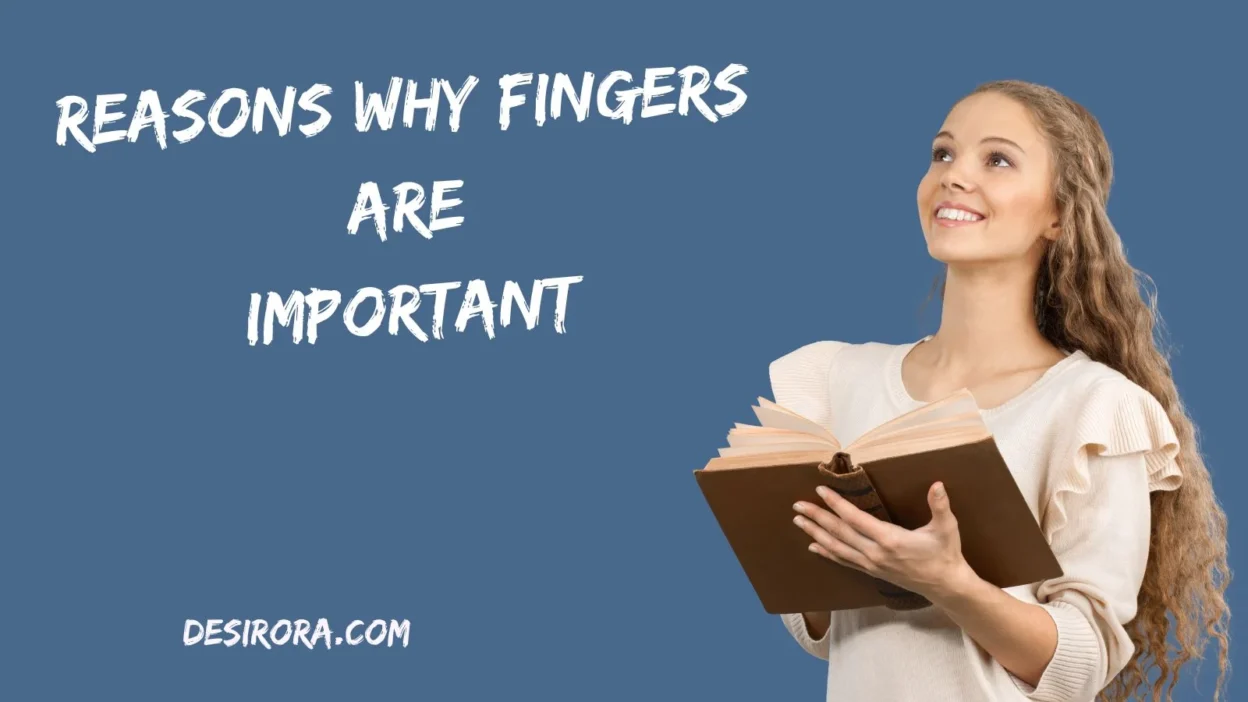Think about your day for a moment. You wake up and turn off your alarm, brush your teeth, scroll through your phone, make breakfast, and maybe even wave hello to someone you love.
Now imagine doing all of that without fingers.
Our fingers are tiny miracles — delicate, powerful, and essential for almost everything we do. They allow us to create, connect, communicate, and survive. From typing an email to painting a masterpiece, from holding a baby’s hand to performing surgery — fingers are at the heart of human experience.
This article explores the many reasons why fingers are important, how they shape our lives, and why caring for them matters more than most people realize.
The Anatomy of Fingers and Their Unique Design
Fingers are marvels of biological engineering. Each hand has five digits, made up of bones, muscles, tendons, ligaments, and nerves that work together with stunning precision.
Here’s a quick look at the structure:
| Part | Function |
| Phalanges (bones) | Give structure and flexibility |
| Joints | Allow bending and gripping |
| Tendons | Connect muscles to bones for movement |
| Nerves | Transmit sensations like pain and touch |
| Skin and fingerprints | Provide grip and sense of texture |
Unlike most animals, human fingers don’t have muscles inside them — they move thanks to muscles in the forearm and palm pulling on tendons. This design gives us incredible fine motor control.
Everyday Reasons Why Fingers Are So Important
Our fingers might look small, but their role in daily life is enormous. Here are some key reasons why they’re indispensable.
Communication and Expression
Fingers are powerful tools for non-verbal communication.
We use them to point, gesture, wave, count, signal, and express emotions. In many cultures, gestures like a thumbs-up or peace sign have deep meaning.
And for those who are hearing-impaired, sign language turns fingers into a complete communication system — a living, expressive language.
Touch and Sensation
Our fingertips are among the most sensitive parts of the human body.
They contain thousands of nerve endings that detect pressure, texture, temperature, and pain. This allows us to recognize objects by touch alone — like feeling fabric texture or checking water warmth.
Touch is also emotional. It connects people. Holding hands, a gentle tap on the shoulder, or the touch of a loved one — these gestures communicate comfort, trust, and affection.
Dexterity and Fine Motor Skills
From buttoning a shirt to writing your name, fingers handle delicate movements that require fine motor coordination.
Artists, musicians, surgeons, and writers all depend on finger dexterity for their craft. Without it, even the simplest tasks would be nearly impossible.
Grip and Strength
Your fingers help you grip, hold, lift, and control objects. There are several types of grips we use every day:
- Power grip — holding a hammer or a bottle
- Pinch grip — picking up small objects
- Hook grip — carrying a shopping bag
- Precision grip — writing with a pen or threading a needle
This combination of power and precision sets humans apart from most animals.
Creativity and Artistry
Fingers turn imagination into reality. Painters use them to shape color, sculptors to mold form, and musicians to produce sound.
Even digital artists and photographers rely on finger control to create art that moves the world.
The Role of Fingers in Different Fields of Life
Fingers influence nearly every profession and passion. Let’s explore a few examples.
In Music and Performance
Think about pianists, guitarists, violinists, or drummers — their fingers are their instruments.
Each movement must be precise, rhythmic, and coordinated. The same goes for dancers, magicians, and puppeteers who use their fingers to captivate audiences.
In Sports and Athletics
From gripping a baseball bat to catching a football, fingers are vital in sports.
Climbers, gymnasts, and martial artists depend on finger strength and flexibility for balance, control, and endurance. Even a minor finger injury can affect an athlete’s performance dramatically.
In Medicine and Surgery
Surgeons use their fingers as extensions of their minds — performing delicate operations that save lives.
Dentists, physiotherapists, and massage therapists also rely heavily on their sense of touch and precision.
In Technology and Innovation
Touchscreens, keyboards, and controllers all depend on finger interaction.
Our modern digital world runs on taps, swipes, and clicks — actions that are impossible without fingers. Engineers, programmers, and gamers know this all too well!
Psychological and Emotional Importance of Fingers
Gestures and Body Language
Fingers play a major role in expressing feelings without words. A simple wave, point, or snap conveys messages faster than speech.
Gestures can unite or offend, depending on culture, showing how deeply ingrained they are in human psychology.
Connection Through Touch
Touch activates areas in the brain associated with emotion and bonding. Holding hands or giving a reassuring pat can lower stress and strengthen relationships.
In short, our fingers aren’t just physical tools — they’re emotional bridges.
Types of Fingers and Their Unique Functions
Each finger has a personality of its own. Together, they form a perfectly balanced team.
| Finger | Nickname | Key Role |
| Thumb | The Power Digit | Gripping, stability, control |
| Index Finger | The Pointer | Directing, selecting, pressing |
| Middle Finger | The Balancer | Strength, stability |
| Ring Finger | The Connector | Symbolism, balance, coordination |
| Little Finger (Pinky) | The Supporter | Precision, small-scale strength |
Thumb – The Power Digit
The thumb sets humans apart from most animals. Its opposable nature allows gripping, twisting, and holding — from opening jars to using tools.
Index Finger – The Pointer and Director
Used to point, press buttons, or scroll on screens, the index finger leads the way in coordination and control.
Middle Finger – Balance and Strength
This finger provides balance when gripping objects. It also contributes to the force behind a firm hold.
Ring Finger – Connection and Symbolism
Traditionally linked to love and commitment, the ring finger symbolizes human emotion.
It also helps stabilize hand movements, especially when writing or playing instruments.
Little Finger – Support and Precision
Though small, it’s essential for balance and grip. Losing it can reduce hand strength by up to 50%.
Real-Life Examples of How Fingers Shape Our Daily Lives
Let’s bring this closer to home with real examples of finger use in everyday life.
- Typing: Every word you read online starts with fingers tapping a keyboard.
- Cooking: From slicing vegetables to kneading dough, fingers guide the process.
- Crafting: Artists, carpenters, and jewelers use fine finger control to shape raw materials into beauty.
- Medical technology: Surgeons perform robotic-assisted operations using fingertip precision.
- Sign language: Millions of people communicate through the language of fingers every day.
Protecting and Caring for Your Fingers
Your fingers work hard for you — so take care of them! Here’s how.
Ergonomics and Safe Practices
- Avoid repetitive strain by taking breaks when typing or gaming.
- Maintain a neutral wrist position when working.
- Use tools that fit comfortably in your hand.
Exercises for Finger Strength and Flexibility
Try these quick stretches:
- Finger curls: Make a fist, then open fully.
- Finger lifts: Place your hand flat and lift one finger at a time.
- Thumb opposition: Touch your thumb to each fingertip in sequence.
Dealing with Finger Injuries and Pain
Sprains, fractures, or arthritis can affect mobility. Early medical attention and gentle rehab exercises can help restore function.
Remember: healthy fingers mean an active, independent life.
The Symbolic and Cultural Importance of Fingers
Across cultures, fingers hold deep symbolic meaning.
Rings, Gestures, and Cultural Meaning
- Wedding and engagement rings symbolize love and loyalty.
- The index finger often denotes authority or direction.
- In many Eastern traditions, mudras (symbolic hand gestures) are used in meditation and yoga to channel energy.
Fingerprints and Identity
No two fingerprints are alike. They represent individuality and uniqueness — key to identification, security, and self-expression.
Conclusion — Small Parts, Big Impact
Our fingers may be small, but their impact on human life is immeasurable.
They’re the reason we can create art, connect with others, build civilizations, and express emotions. Each movement, touch, and gesture tells a story — the story of human potential and connection.
So next time you glance at your hands, take a moment to appreciate the tiny marvels at the end of your arms.
They’re not just fingers — they’re the foundation of human creativity, communication, and care.
FAQs
Q1: Why are fingers so important to humans?
Because they allow precise movement, touch, communication, and creativity — essential for survival and emotional connection.
Q2: Which finger is the most important?
While the thumb is crucial for grip and function, every finger has a unique role that contributes to balance and coordination.
Q3: How do fingers help in communication?
Through gestures, sign language, and touch, fingers express emotions and ideas that words sometimes can’t.
Q4: What happens if you lose a finger?
Losing a finger affects grip strength, coordination, and dexterity — though therapy and prosthetics can help restore function.
Q5: How can I keep my fingers healthy?
Regular stretching, good ergonomics, and protecting them from injuries or strain will keep your fingers strong and flexible.

Thomas Hardy is a passionate innovator and thoughtful leader, dedicated to transforming ideas into lasting success. With creativity and purpose, he brings vision and authenticity to everything he does.



